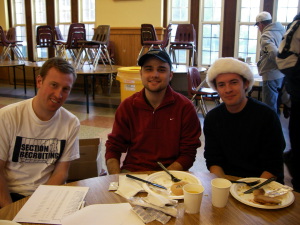Breakfast with Santa
- Details
- Hits: 4229
 The Scarsdale Village Recreation Department and the Chamber of Commerce sponsored breakfast with Santa on Saturday morning December 11th, and fun was had by all. Over 130 children signed up to come to Scarsdale High School to meet Santa and have their photos taken with him. Also on hand was Lange’s with a complimentary pancake breakfast and coffee. Children were kept busy creating gingerbread houses with crafts projects supplied by the Recreation Department.
The Scarsdale Village Recreation Department and the Chamber of Commerce sponsored breakfast with Santa on Saturday morning December 11th, and fun was had by all. Over 130 children signed up to come to Scarsdale High School to meet Santa and have their photos taken with him. Also on hand was Lange’s with a complimentary pancake breakfast and coffee. Children were kept busy creating gingerbread houses with crafts projects supplied by the Recreation Department.
Thanks to Dan Walczewski at the Recreation Department, Langes and the Chamber of Commerce for hosting a successful event.



Too Smart to Fail
- Details
- Hits: 5505
 Scarsdale’s own journalist and author Andrew Ross Sorkin returned to town last night and was welcomed by an overflowing crowd at the Scarsdale Library. Sorkin was invited by the Friends of the Library to discuss his best-selling book, “Too Big To Fail” which chronicles the events and the players in the financial crisis that hit the news in September 2008. He greeted the community as well as Peter Haupt, his fifth grade teacher from the Fox Meadow School, and David Greene, who served as his Senior Options Advisor at SHS in 1995. He credited Mr. Greene with getting him started on his successful career by helping him to strategize on how he could get a spot at the NY Times for his Senior Option. Those five weeks shaped his life as he ultimately worked at the Times after college and is now their Mergers and Acquisitions Reporter as well as the Editor of the Time’s online financial blog, DealBook. He had just come from a taping of an interview with Jon Stewart at the Daily Show. Stewart opened by asking the youthful Sorkin his age and when Sorkin told him he was 32, Stewart said, “where do you keep yourself? In a vegetable crisper?” At 624 pages, Stewart also claimed the book should be called “Too Big To Read,” so fortunately for us, Sorkin was on hand to give us the highlights. Watch the Stewart spot here.
Scarsdale’s own journalist and author Andrew Ross Sorkin returned to town last night and was welcomed by an overflowing crowd at the Scarsdale Library. Sorkin was invited by the Friends of the Library to discuss his best-selling book, “Too Big To Fail” which chronicles the events and the players in the financial crisis that hit the news in September 2008. He greeted the community as well as Peter Haupt, his fifth grade teacher from the Fox Meadow School, and David Greene, who served as his Senior Options Advisor at SHS in 1995. He credited Mr. Greene with getting him started on his successful career by helping him to strategize on how he could get a spot at the NY Times for his Senior Option. Those five weeks shaped his life as he ultimately worked at the Times after college and is now their Mergers and Acquisitions Reporter as well as the Editor of the Time’s online financial blog, DealBook. He had just come from a taping of an interview with Jon Stewart at the Daily Show. Stewart opened by asking the youthful Sorkin his age and when Sorkin told him he was 32, Stewart said, “where do you keep yourself? In a vegetable crisper?” At 624 pages, Stewart also claimed the book should be called “Too Big To Read,” so fortunately for us, Sorkin was on hand to give us the highlights. Watch the Stewart spot here.
{mosimage}Sorkin explained that the book was based on over 200 interviews and 800 hours of conversations with bank CEO’s, government officials, and regulators. Modeled on the movie “Crash”, he develops individual story lines simultaneously and has the plot lines converge in the end. Rather than pass judgment on people or events, he has chronicled what happened and leaves the reader to decide who are the heroes and who are the villains. Though he began his research by asking for traditional interviews, he quickly realized that in order to get the real story he would have to permit the bankers to speak off the record. And once he did, vivid, detailed stories of the crisis and bailout emerged. Those involved were eager to reconstruct the events as they felt these historic times should be studied and remembered.
Sorkin revealed a few surprises uncovered during his research. Though the public first heard of the impending crisis in September 2008, conversations with bankers showed that they knew of the impending collapse as early as the previous spring and indeed the TARP (Troubled Asset Relief Program) plan had been drafted in April, 2008. Though the government was not sounding alarms at the time, the crisis was quietly emerging.
Was the bailout necessary? According to Sorkin, after the collapse of Lehmann Brothers Morgan Stanley, Goldman Sachs and General Electric were at risk of failing within days. The government bailed out AIG because they had insured many of the banks on their investment in toxic assets, and with that bailout money AIG was able to make good on these claims, helping the bank counterparties, which in turn helped to shore up stability and confidence. If General Electric defaulted, Sorkin told the audience the crisis would have moved from Wall Street to Main Street as smaller companies would not have been able to meet their payrolls. Who was at fault? According to Sorkin though we blame the players on Wall Street for creating the crisis, these are the same people who in the end saved the country from financial collapse.
Has anything changed? Unfortunately not. In his opinion, new regulations have not been passed and the banks are back to their old ways. Sorkin suggests that the banks are now paying back the bailout funds they received, not because it is the best move for the financial system, but simply because it will allow them to pay out bigger bonuses to valued employees. Sorkin feels that one way to prevent a reoccurrence of the crisis would be to raise capital requirements and require banks to hold larger reserve funds. Though this would create greater stability and reduce the risk of their default, it would prevent them from distributing big bonuses and limit their ability to make loans.
Are we out of the woods? Unfortunately the answer to that question was “no” again. He told the audience that he watches a key employment statistic as a bell weather and notes that the “average hours worked per week” in the U.S. now stands at only 33 hours. Before companies will hire, he believes they will increase the hours of current employees and right now the picture looks grim.
Sorkin has written a book that it is sophisticated enough for his Dad, an anti-trust lawyer, but accessible to his Mother who is a playwright. Though it deals with complex financial terminology, the book also delves into the lives of high-flying bankers, exploring their lifestyles, motivations, petty jealousies and personal relationships that influenced their actions.
An impressive, confident well-versed speaker, Sorkin claimed that he was only a “meager journalist.” But his performance last night displayed his brilliant insights into extremely complex issues. If he is the product of a Scarsdale education, we can all feel good about what our schools have to offer.
Comprehensive Village Plan Approved
- Details
- Hits: 4875
The Planning Board of the Village of Scarsdale met on November 18th to consider their recommendation to the Village Board on the adoption of the updated Comprehensive Village Plan. Why was the updated study undertaken? According to the Plan, “the Planning Board initiated the 2009 Village Center Comprehensive Plan (the Plan) to take a fresh look at the Village Center in the wake of recent development. Incorporating citizen input, the Plan strives to ensure a future in which the best aspects of the Village Center are preserved, valuable aspects are enhanced, and others are rethought for the betterment of everyone. This plan for the Village Center serves as an update to the 1994 Comprehensive Plan’s recommendations for the Village Center, and represents a policy foundation for future planning, zoning, and development actions.”
The current study is an update to a plan written in 2006 that sought to: “Ensure a comprehensive perspective, so planning and development is not an ad hoc process but rather conducted in a coordinated and integrated manner; and, preserve, protect, and enhance the Village Center’s character, function and value.”
At an October 6th meeting with the community, Village Planner, Elizabeth Marrinan, explained the goals of the comprehensive plan and its role in development.
The plan outlines six overarching goals for Scarsdale Village:
- Protect the Village Center feeling, including its scale and character. Adhere to Scarsdale design principles
- Attend to traffic congestion, and enhance walk-ability and pedestrian safety and amenities. Maintain an acceptable level of parking availability
- Contribute to shopping and dining variety
- Provide or connect assets to each other
- Embrace innovation and “green” principles
- Be fiscally responsible
The Comprehensive Plan designates three areas for development; Spencer/Christie Place, Scarsdale Avenue, and the Freightway Lot. For each site the plan provides three options; one to do nothing, two to ease some restrictions and the third to rezone to allow more uses and density. For each of the three areas there is the possibility of increased retail and residential use as well parking to accommodate increased traffic.
For Scarsdale Avenue the plan suggests a “Restaurant Row” to give area residents more variety in dining options. The plan addresses the village’s stringent parking requirements that currently prevent restaurants and businesses from opening in our downtown area. If the plan is adopted by the Village Trustees, a next step could be to adopt zoning changes that correspond with the plan.
At the most recent meeting on November 18th, the Planning Board considered adopting the Plan and making a recommendation to the Village Board to approve it. David Karp, Chairman of the Planning Board explained that the update provides clarification on how Spencer and Christie Place will be developed and calls for staged development to minimize the impact on existing lessees. The new plan also calls for a parking demand analysis.
Members of the community were present to give their input. The League of Women Voters expressed concern about development on Scarsdale Avenue and the impact of multi-story buildings on views. They also felt that the plan would increase traffic on Spencer and Christie Place and that it fails to provide for more reasons for residents to visit the Village at night.
Ed Morgan of the Scarsdale Arts Council asked for permission to include a movie theatre or a cultural venue downtown and an Overhill resident expressed concern about potential noise from increased traffic on Scarsdale Avenue. David Buchen brought up the mandate for workforce housing and questioned how the size of a building at Freightway could be impacted. A shop owner asked how the plan would bring more people into the village at night and wondered how current retailers would be impacted by more construction in the village.
A past president of the Overhill Association let the Board know that he was not in favor of workforce housing on Christie Place and questioned the need for additional commercial space. He stated his support of the “do nothing” option. Another resident expressed his concern that development on Scarsdale Avenue would increase traffic, exacerbate pedestrian safety issues and actually hurt rather than help shop owners.
Bart Hamlin encouraged the board to take proactive steps to encourage green development at the time that planning is in process.
David Karp warned the group that sometimes “doing nothing” could be doing harm and assured residents that the goal of the plan is to maintain what we value about Scarsdale. He offered to prepare a supplemental letter to address green initiatives, zoning for a theatre downtown, and noise abatement.
The Planning Board approved the Comprehensive Plan and will send it to the Village Board with a recommendation for adoption.
Noreen Fisher and Helene Orce Honored
- Details
- Hits: 4697
 Two outstanding volunteers were honored by the Scarsdale Teen Center on Sunday December 6, 2009. The Scarsdale High School cafeteria was packed with well-wishers, on hand to celebrate Noreen Fisher and Helene Orce. Proclamations by State and Village officials were made and family members shared perspectives on contributions made to the community by Noreen and Helene. Two members of the Teen Board presented plaques to the honorees. Delicious food and beautiful decorations donated by local merchants helped make the event a wonderful opportunity to acknowledge the contributions of Noreen and Helene.
Two outstanding volunteers were honored by the Scarsdale Teen Center on Sunday December 6, 2009. The Scarsdale High School cafeteria was packed with well-wishers, on hand to celebrate Noreen Fisher and Helene Orce. Proclamations by State and Village officials were made and family members shared perspectives on contributions made to the community by Noreen and Helene. Two members of the Teen Board presented plaques to the honorees. Delicious food and beautiful decorations donated by local merchants helped make the event a wonderful opportunity to acknowledge the contributions of Noreen and Helene.













